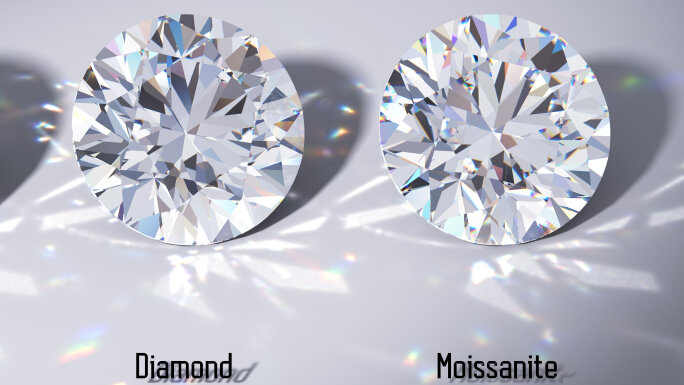When it comes to choosing the perfect gemstone, whether for an engagement ring, earrings, or a timeless pendant, the decision often narrows down to two sparkling contenders: diamonds and moissanites. Both stones offer remarkable brilliance and durability, but they tell very different stories when it comes to origin, composition, price, and appearance. Understanding the key distinctions in the diamond vs moissanites debate is essential for making an informed and meaningful purchase.
For decades, natural diamonds were the ultimate standard of luxury. Their rarity and symbolism have made them prized possessions for generations. However, as consumer values shift towards ethics, sustainability, and individuality, alternatives like moissanite have surged in popularity. At the same time, innovation has introduced a new way to experience the timeless appeal of a diamond through lab grown diamonds, which offer all the beauty of a mined diamond without the environmental and ethical concerns.
In this guide, we’ll explore the similarities and differences between diamonds and moissanites from multiple perspectives: visual beauty, durability, cost, environmental impact, and long-term value.
Table of Contents
The Science Behind the Sparkle
To appreciate the differences between diamonds and moissanites, it’s helpful to understand what each stone actually is. Diamonds whether mined or lab-grown are made entirely of carbon atoms arranged in a crystal structure that gives them their famous hardness and brilliance. Lab-grown diamonds, in particular, are identical to natural diamonds in every physical, chemical, and optical property.
Moissanite, on the other hand, is made of silicon carbide. It was first discovered in a meteor crater and later replicated in laboratories. Though it is not a diamond, moissanite is a gemstone in its own right, with unique qualities that appeal to modern consumers.
Both gems sparkle. Both are durable. But beneath the surface, they’re built differently and that difference impacts how they look, feel, and perform.
Brilliance and Fire: How They Catch the Light
One of the biggest visual differences between diamonds and moissanites lies in how they reflect light. Diamonds are known for their brilliance (white light reflection) and fire (colored light dispersion). They exhibit a classic sparkle that is often described as sharp, icy, or elegant.
Moissanites, on the other hand, tend to produce more fire sometimes noticeably more. This can give them a rainbow-like flash in direct light, which some people find dazzling, while others see it as slightly artificial or less refined. Under natural lighting, a moissanite may seem a touch more vibrant or “disco-ball-like” compared to the cool sparkle of a diamond.
If you’re someone who loves maximum shimmer and don’t mind a more flamboyant light play, moissanite may appeal to you. If you prefer the more understated, traditional sparkle, a diamond especially a lab grown diamond might be the better choice.
Durability and Daily Wear
Durability is another crucial factor, especially for everyday pieces like engagement rings or wedding bands. Diamonds top the Mohs scale of hardness at 10, making them the hardest known natural material. This means they are highly resistant to scratching and wear.
Moissanites rank 9.25 on the Mohs scale, which is still excellent. They are harder than most gemstones, including sapphires and emeralds, but slightly softer than diamonds. For most people, the difference in hardness will rarely be noticeable in daily life. However, if you work with your hands or plan to wear your jewelry daily for decades, the added durability of a diamond may be worth the investment.
Price and Affordability
One of moissanite’s biggest advantages is its price. A moissanite of similar size and appearance to a diamond typically costs a fraction of the price sometimes up to 90% less. This makes moissanite a popular option for couples seeking larger stones on a budget or allocating more money to their wedding, honeymoon, or home.
That said, lab grown diamonds have closed the affordability gap significantly. While they’re more expensive than moissanites, they cost significantly less than mined diamonds often 30–50% less while offering the same look and feel as their natural counterparts.
This middle-ground pricing gives lab-grown diamonds an edge for buyers who want the prestige and authenticity of a real diamond without the environmental or ethical cost or the steep price tag.
Ethical and Environmental Impact
In the past, many diamonds were associated with conflict zones and unethical mining practices. Although the industry has improved with initiatives like the Kimberley Process, concerns still exist regarding environmental degradation and labor exploitation.
Moissanites are exclusively lab-created, so their ethical and environmental footprint is generally small. Likewise, lab-grown diamonds are produced in controlled environments, eliminating the need for mining altogether. They use significantly less water and energy and don’t disturb ecosystems.
If sustainability and ethical sourcing are important to you, both moissanite and lab-grown diamonds are superior choices to mined stones. However, those who still want a “real” diamond without the social and environmental concerns will often lean toward lab-grown options.
Resale Value and Longevity
When it comes to long-term value, diamonds particularly mined ones have traditionally held better resale value than moissanites. That said, lab-grown diamonds are slowly gaining traction in the resale market, though they still don’t command the same resale prices as mined stones.
Moissanites, being more affordable and not classified as diamonds, don’t typically carry strong resale value. They’re often purchased with the understanding that their worth lies in their personal meaning, not their investment potential.
If long-term financial value is a key concern for you, diamonds (mined or lab-grown) may still be the better choice. But for buyers focused on beauty, sentiment, and budget, moissanite remains a compelling option.
Appearance Over Time
Both moissanites and diamonds retain their sparkle over time. Diamonds may require occasional cleaning to remove oil or residue but do not cloud or dull. Moissanites are similarly resilient, though some users report a “haziness” over time under heavy use. Regular cleaning can prevent this and keep the gem looking its best.
One notable difference is that diamonds (especially those with high clarity) can maintain a crisp, clear look for decades. Moissanites may exhibit a slightly milkier tone under certain lighting or conditions, though this varies by stone and personal perception.
Making the Right Choice for You
Choosing between a diamond and a moissanite is a personal decision shaped by values, style, and priorities. For many, the symbolism of a diamond especially one that’s ethically created makes it the gemstone of choice for life’s most important milestones. Others might favor the budget-friendliness and brilliance of moissanite, especially when appearance matters more than tradition.
A lab grown diamond offers a compelling solution that combines ethics, affordability, and authenticity. It’s a real diamond without the baggage of mining or the premium cost, and it aligns beautifully with modern values.
On the other hand, moissanite stands out as a unique gemstone with its own identity one that’s accessible, sparkly, and ideal for those who want something different without compromising on shine.
Conclusion: Both Beautiful, Both Valid
In the ongoing comparison of diamond vs moissanites, there’s no absolute winner only what feels right for you. If you’re looking for the enduring symbolism of a true diamond with a modern conscience, a lab-grown diamond might be your perfect match. If you’re drawn to extraordinary sparkle, affordability, and are open to non-traditional options, moissanite may be just what you’re looking for.
Whichever path you choose, the beauty of today’s gem market is the freedom it offers. You no longer have to compromise between ethics, beauty, and budget. You simply have to decide what matters most to you and then let your gemstone tell that story.









